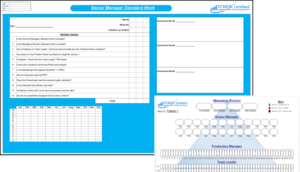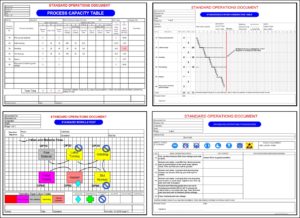Continuous Improvement, The 1% rule, or Marginal Gains, whatever terminology you want to call it, they are all similar in philosophy and application. It is the idea of focusing on small incremental improvements to grow your business easily. The most successful businesses are always striving to improve to stay ahead of their competition.
In this blog I’ll explain how the philosophy of small incremental improvements can improve your business. This is a technique that many successful companies use in addition to Lean Thinking – a company’s philosophy of eliminating waste. It has been used for decades and can be found in micro businesses right through to corporate business models across industry and service sectors.
I’ve been a lean Sensei for 25+ years and implemented these small incremental changes in Hairdressers to Big Corporate Manufacturers. By implementing these marginal gains, it’s possible to make a huge impact on the performance of your company in a relatively short period of time. It’s Simple! and the data has proven time and time again that this method works!
You CAN NOT ignore the role of Continuous Improvement in business – and here’s why.
What is Continuous Improvement?
“Be Better Today Than You Were Yesterday, Plan To Be Better Tomorrow Than You Are Today” is a quote I have lived by for 25+ years of my working career.
The 1% Rule is a relatively new contender but has now become a business management philosophy that states that you should focus on improving your product or service by at least 1% every day. It was developed by Sir Dave Brailsford, former performance director of British Cycling, and used as a means to achieve micro improvement in the British Cycling Team. The concept behind the 1% rule is simple: if you focus on small improvements, you can achieve significant results over time.
The concept of the 1% rule in my opinion is based on Kaizen, which is Japanese for “continuous improvement.” Kaizen was first introduced to the Western World in the 1970s by Toyota, who taught that companies should embrace a culture of continuous improvement rather than trying to maximise efficiency one big hit at a time. Kaizen aims to reduce inefficiency in its 3 major forms. These are muda (waste), muri (overburdening work), and mura (inconsistency of work).
When we look at these strategies, we can see how the power of tiny gains really makes a difference.
1% Improvement Every Day 1.01365 = 37.78%
1% Decline Every Day 0.99365 = 0.03%
How does the Continuous Improvement work in business?
The PDCA Cycle, also known as the Plan-Do-Check-Act Cycle, is a model for continuous improvement that uses four phases to drive process changes through the organisation. This linked to the 3 forms of in-efficiency, muda (waste), muri (overburdening work), and mura (inconsistency of work) gives a superb structure and focus for all employees.
The PDCA Cycle Explained:
Plan: In this phase, you identify a problem or opportunity for improvement. You also create a plan for how to solve the problem or capitalise on the opportunity.
Do: In this phase, you carry out your plan and implement your solution.
Check: In this phase, you review your work to see if it was successful in achieving its objectives and if there are any unintended consequences of your actions.
Act: In this phase, you make adjustments based on what you learned in the check phase and continue with another iteration of the cycle to drive continuous improvement.
By continuously improving your processes, your organisation can achieve higher levels of performance at lower cost. This not only improves customer satisfaction but also helps an organisation achieve its goals faster.
The key to this and building on the marginal gains is to empower everyone to make these short, sharp improvement cycles small enough to be managed at a local level. This will enable them to use their creativity and judgment to find the most effective solution for their teams and customers.
The second aspect of this is that the improvements have to be visible and celebrated. This is not just about being proud of what you have achieved, but also about helping others see what you have done. This creates an environment where people are constantly looking for new ways to improve, which in turn leads to innovation.
The third aspect is that it has to be built into every process in a business. You cannot expect people just to do it because you asked them to – they need processes that encourage continuous improvement across everything they do from how they order stock through the distribution system all the way through customer support.
Why use the Continuous Improvement?
Continuous improvement is a process that can be used in every business setting of all sizes and all sectors, from small businesses to large corporations.
It’s Good for Business
The benefits of continuous improvement can be seen throughout the business world. By using this approach, companies are able to stay competitive while providing better quality products and services at lower prices. This helps them grow their customer base while increasing their profit margin through increased sales volume.
It’s Good for Employees
Continuous improvement is also good for employees because it provides them with job security. If you have implemented a continuous improvement program in your company, then you have created an environment where everyone is constantly making improvements which makes your company more competitive in the marketplace and less likely to be outsourced in favour of cheaper labour costs elsewhere.
- People feel empowered because they have more opportunities for growth and development.
- Employees feel more engaged because they feel like their work matters and makes a difference.
- The company attracts better talent because employees want to work for companies that are doing great things for their customers.
Does Continuous Improvement really work?
Yes! Continuous Improvement absolutely works!
I’ve implemented and completed Lean Thinking and Continuous Improvement Projects in 100+ businesses over my career and have no doubt on the impact it can make.
On my very first project back in the 1990’s we took a machine change over from 480 mins to sub 20 mins, saving a £250K capital expenditure. As Senior Exec I’ve saved £10m+ year on year through the implementation of Continuous Improvement. I’ve seen every employee within a business take pride in completing numerous small incremental changes that compound in delivering a huge result.
In order to achieve these results, you need to be prepared to put in the work. It’s not an overnight process—it takes patience as well as an unwavering commitment to creating positive change at every level of your organisation. But once you’ve seen the first results, you’ll find it’s worth every minute invested!
You’ve only got to read some of our Case Studies to realise the potential.
Takeaway: Challenging yourself and your employees to make small improvements every day can have a dramatic effect on your overall business growth.











